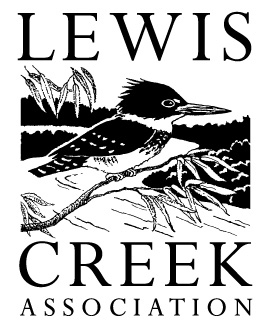Yellow iris (Iris pseudacorus), with its striking yellow flowers provides a colorful addition to the Vermont landscape - and a threat to our priority natural communities. In recent years, it has gained a foothold in many Lake Champlain wetlands and flood plain forests of Champlain direct drainage streams. Both are priority natural communities, as documented by Vermont Fish & Wildlife Natural Heritage Program. Lewis Creek Association in partnership with Lake Champlain Basin Program and Habitat Restoration Solutions began studying this problem in 2015. Control efforts were initiated in 2016 for lower Lewis Creek and this past summer for Thorp Brook.
“This year’s control work builds upon two seasons of studying and mapping iris infestation, threat and spread; and validating control methods in the lower reaches of Thorp Brook”, according to Bob Hyams of Habitat Restoration Solutions. Lower Thorp Brook is a diverse beaver-influenced corridor and serves as the primary iris seed source for the wetlands at its confluence with Lake Champlain. These wetlands are considered state waters, comprising of a fifty-three-acre matrix of wetland natural communities, whose value has been acknowledged by Vermont Department of Environmental Conservation, experts at The Nature Conservancy, and others.
The lake-influenced lower reaches of Lewis Creek contain important floodplain forests, buttonbush swamps and a range of state significant emergent communities. Lands are state-owned (Little Otter Wildlife Management Area) and private. While the extent and nature of the infestation was understood and mapped, a mutually agreeable management approach was needed to begin addressing this growing infestation in an ecologically significant area of high public value.
Iris clump growth rates season-to-season have been observed to exceed 100% (2015-17). Iris will raise elevations of wetlands over time, effectively eliminating emergent plant communities. In addition to disrupting natural riparian communities in Thorp, these stands serve as the primary seed source for Thorp/Kimball wetlands.
This past summer, an invasive species management plan was developed for Thorp Brook. Iris clumps were identified in early summer by Habitat Restoration Solutions and a team of volunteers when the flowers were recognizable. With landowner permission, clumps were treated with foliar herbicide in the fall, yielding 90 percent control. In lower Lewis Creek, property management options were identified by reaching out to landowners and technical experts. This project initiated a broader discussion in Lewis Creek about taking care of this valuable natural asset. Thank you to the landowners along Thorp Brook and Lewis Creek for participating in this important work.
